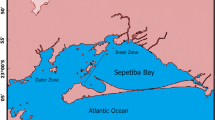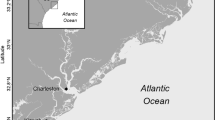Abstract
As human development in coastal areas increases, the role of anthropogenically-created habitats in the life history of marine organisms is becoming increasingly important. We examined the diet of age-0 tarpon, Megalops atlanticus, in and around man-made mosquito control impoundments along the Indian River Lagoon in east-central Florida, with a particular focus on identifying dietary patterns associated with tarpon size and nursery habitat type (i.e., between perimeter pool habitats in established impoundments and newly-created restoration marsh habitats). Age-0 tarpon were found to consume a wide variety of prey organisms, and exhibited considerable dietary variation among study sites. Smaller juvenile tarpon consumed a limited number of small prey taxa, while larger individuals fed on a greater range of prey taxa and sizes. Overall, copepods and fishes were the dominant prey items; however, the consumption of these organisms varied considerably among size classes and sites. There was no clear difference in tarpon diet between the two types of habitat we examined. The ability of juvenile tarpon to utilize such a diverse range of prey organisms may allow populations to inhabit a variety of habitats, including man-made marshes. When natural systems have been degraded or destroyed, human-altered habitats can assume a nursery role for the species.





Similar content being viewed by others
References
Adams AJ, Wolfe RK, Layman CA (2009) Preliminary examination of how human-driven freshwater flow alteration affects trophic ecology of juvenile snook (Centropomus undecimalis) in estuarine creeks. Estuar Coast 32:819–828
Borcherding J, Hermasch B, Murawski P (2007) Field observations and laboratory experiments on growth and lipid content of young-of-the-year perch. Ecol Freshw Fish 16:198–209
Brockmeyer RE, Rey JR, Virnstein RW, Gilmore RG, Earnest L (1997) Rehabilitation of impounded estuarine wetlands by hydrographic reconnection to the Indian River Lagoon, Florida (USA). Wetlands Ecol Manag 4:93–109
Catano S, Garzon-Ferreira J (1994) Ecologica trofica del sabalo Megalops atlanticus (Pisces: Megalopidae) en el area de Cienaga Grande de Santa Marta, Caribe colombiano. Rev Biol Trop 42:673–684
Chacon-Chaverri D (1994) Ecologica basica y alimentacion del sabalo Megalops atlanticus (Pisces: Megalopidae). Rev Biol Trop 42:225–232
Cortes E (1997) A critical review of methods of studying fish feeding based on analysis of stomach contents: application to elasmobranch fishes. Can J Fish Aquat Sci 54:726–738
Crabtree RE, Cyr EC, Dean JM (1995) Age and growth of tarpon, Megalops atlanticus, from South Florida waters. Fish Bull 93:619–628
Crabtree RE, Stevens C, Snodgrass D, Stengard FJ (1998) Feeding habits of bonefish, Albula vulpes, from the waters of the Florida Keys. Fish Bull 96:754–766
Cutwa MM, Turingan RG (2000) Intralocality variation in feeding biomechanics and prey use in Archosargus probatocephalus (Teleostei, Sparidae), with implications for the ecomorphology of fishes. Environ Biol Fish 59:191–198
Guigand CM, Turingan RG (2002) Feeding behavior and prey capture kinematics of juvenile tarpon (Megalops atlanticus). Contrib Mar Sci 35:43–54
Harrington RW (1958) Morphometry and ecology of small tarpon, Megalops atlantica Valenciennes from transitional stage through onset of scale formation. Copeia 1958:1–10
Harrington RW, Harrington ES (1960) Food of larval and young tarpon, Megalops atlantica. Copeia 1960:311–319
Harrington RW, Harrington ES (1961) Food selection among fishes invading a high subtropical salt marsh: from onset of flooding through the progress of a mosquito brood. Ecology 42:646–666
Howells RG (1985) Cold tolerance of juvenile tarpon in fresh water. Proc Tex Chapter Am Fish Soc 8:26–34
Hynes HBN (1950) The food of fresh-water sticklebacks (Gasterosteus aculeatus and Pygosteus pungitius) with a review of methods used in the studies of the food of fishes. J Anim Ecol 19:36–58
Hyslop EJ (1980) Stomach contents analysis—a review of methods and their application. J Fish Biol 17:411–429
Langeland A, Nøst T (1995) Gill raker structure and selective predation on zooplankton by particulate feeding fish. J Fish Biol 47:719–732
Layman CA, Silliman BR (2002) Preliminary survey and diet analysis of juvenile fishes of an estuarine creek on Andros Island, Bahamas. Bull Mar Sci 70:199–210
Layman CA, Quattrochi JP, Peyer CM, Allgeier JE (2007) Niche width collapse in a resilient top predator following ecosystem fragmentation. Ecol Lett 10:937–944
Lewis RR, Gilmore RG (2007) Important considerations to achieve successful mangrove forest restoration with optimum fish habitat. Bull Mar Sci 80:823–837
Llanso RJ, Bell SS, Vose FE (1998) Food habits of red drum and spotted seatrout in a restored mangrove impoundment. Estuaries 21:294–306
McMillen-Jackson AL, Bert TM, Cruz-Lopez H, Seyoum S, Orsoy T, Crabtree RE (2005) Molecular genetic variation in tarpon (Megalops atlanticus Valenciennes) in the northern Atlantic Ocean. Mar Biol 146:253–261
Poulakis GR, Shenker JM, Taylor DS (2002) Habitat use by fishes after tidal reconnection of an impounded estuarine wetland in the Indian River Lagoon, Florida (USA). Wetlands Ecol Manag 10:51–69
Shenker JM, Cowie-Mojica E, Crabtree RE, Patterson HM, Stevens C, Yakubik K (2002) Recruitment of tarpon (Megalops atlanticus) leptocephali into the Indian River Lagoon, Florida. Contrib Mar Sci 35:55–69
Shoup DE, Wahl DH (2009) The effects of turbidity on prey selection by piscivorous largemouth bass. Trans Am Fish Soc 138:1018–1027
Stevens PW, Montague CL, Sulak KJ (2006) Patterns of fish use and piscivore abundance within a reconnected saltmarsh impoundment in the northern Indian River Lagoon, Florida. Wetlands Ecol Manag 14:147–166
Stevens PW, Blewett DA, Poulakis GR (2007) Variable habitat use by juvenile common snook, Centropomus undecimalis (Pisces: Centropomidae): applying a life history model in a southwest Florida estuary. Bull Mar Sci 80:93–108
Treloar MA, Laurenson LJB, Stevens JD (2007) Dietary comparisons of six skate species (Rajidae) in southeastern Australian waters. Environ Biol Fish 80:181–196
Turingan RG, Wainwright PC, Hensley DA (1995) Interpopulation variation in prey use and feeding biomechanics in Caribbean triggerfishes. Oecologica 102:296–304
Valentine-Rose L, Cherry JA, Culp JJ, Perez KE, Pollock JB, Arrington DA, Layman CA (2007) Floral and faunal differences between fragmented and unfragmented Bahamian tidal creeks. Wetlands 27:702–718
Vose FE, Bell SS (1994) Resident fishes and macrobenthos in mangrove-rimmed habitats: evaluation of habitat restoration by hydrologic modification. Estuaries 17:585–596
Wade RA (1962) The biology of the tarpon, Megalops atlanticus, and the ox-eye, Megalops cyprinoides, with emphasis on larval development. Bull Mar Sci 12:545–599
Werner EE, Gilliam JF (1984) The ontogenetic niche and species interactions in size-structured populations. Annu Rev Ecol Syst 15:393–425
Zerbi A, Aliaume C, Joyeux JC (2001) Growth of juvenile tarpon in Puerto Rican estuaries. ICES J Mar Sci 58:87–95
Acknowledgments
This research was funded in part through grants provided by Bonefish and Tarpon Trust, the Don Hawley Foundation, and the Florida Fly Fishing Association, as well as a teaching assistantship provided by Florida Institute of Technology. We are particularly grateful for the generous support and unlimited access provided by Jim David and the St. Lucie County Mosquito Control District. The fieldwork carried out during this study would not have been possible without the assistance of John O’Connell, Leslie Martin, Kate Heckman, Mike Gerlach, and Rick Oldham. Tarpon were collected pursuant to Florida Fish and Wildlife Conservation Commission Permit # 06SR-035.
Author information
Authors and Affiliations
Corresponding author
Rights and permissions
About this article
Cite this article
Jud, Z.R., Layman, C.A. & Shenker, J.M. Diet of age-0 tarpon (Megalops atlanticus) in anthropogenically-modified and natural nursery habitats along the Indian River Lagoon, Florida. Environ Biol Fish 90, 223–233 (2011). https://doi.org/10.1007/s10641-010-9734-6
Received:
Accepted:
Published:
Issue Date:
DOI: https://doi.org/10.1007/s10641-010-9734-6




